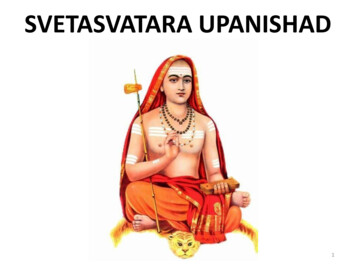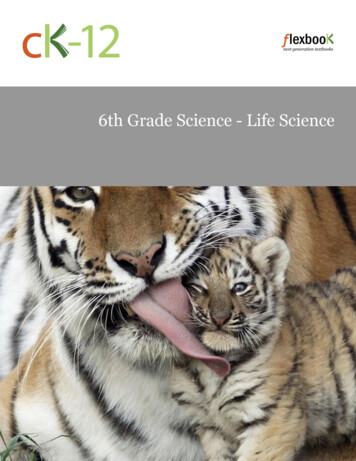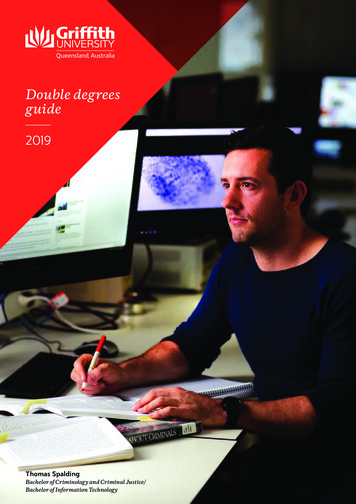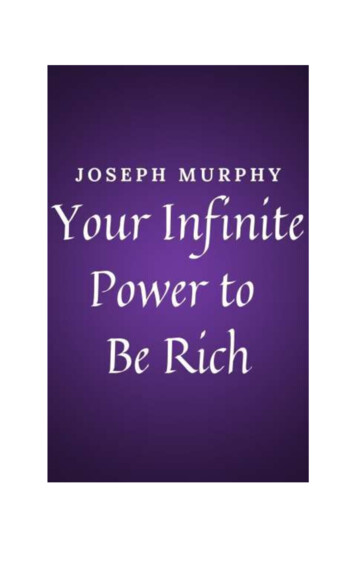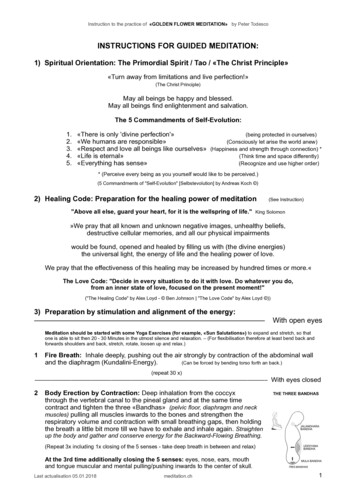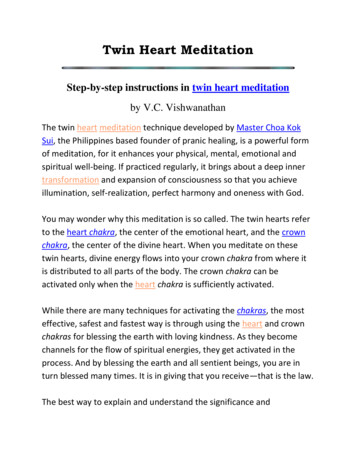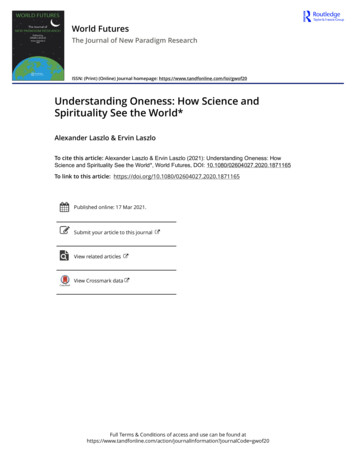
Transcription
World FuturesThe Journal of New Paradigm ResearchISSN: (Print) (Online) Journal homepage: g Oneness: How Science andSpirituality See the World*Alexander Laszlo & Ervin LaszloTo cite this article: Alexander Laszlo & Ervin Laszlo (2021): Understanding Oneness: HowScience and Spirituality See the World*, World Futures, DOI: 10.1080/02604027.2020.1871165To link to this article: shed online: 17 Mar 2021.Submit your article to this journalView related articlesView Crossmark dataFull Terms & Conditions of access and use can be found ation?journalCode gwof20
WORLD 65PERSONAL PERSPECTIVESUnderstanding Oneness: How Science andSpirituality See the World Alexander Laszloand Ervin LaszloThe Laszlo Institute of New Paradigm Research, Friuli-Venezia Giulia, ItalyABSTRACTThe enterprise of science, as a disciplined inquiryinto the nature and workings of the world, is coming to affirm many of the intuitively sensed and viscerally known insights long held by various wisdomtraditions of spirituality. Both science and spiritualityhave come to affirm the essential underlying oneness of the world. How is it that these two traditionsof inquiry, so different in their methodology, havecome to a common meeting ground on the ontology of reality? This essay explores these two perspectives and how each of them expresses theinsights they offer into our miraculously coherentuniverse. Each author addresses these respectiveviews in turn. Ervin Laszlo takes the first part toexplore the view from science and how it has cometo an understanding of the oneness and coherenceof being and the world. Alexander Laszlo takes thesecond part to consider how the view from spirituality relates complementary accounts regarding theunity and coherence of the world. Taken together,these two views of the world provide the understanding of science as well as the consciousness ofspirituality in a holistic conception of being and theworld; what Alfred North Whitehead anticipated asthe possibility that ‘a reconciliation of a deeper religion and a more subtle science will be found.’KEYWORDSCoherence; holotropism;oneness; science; spiritualityCONTACT Alexander Laszloalexander@laszloinstitute.comThe Laszlo Institute of NewParadigm Research, Via Torbandena 1, 34121 Trieste [TS], Friuli-Venezia Giulia, Italy. Material adapted from The Wisdom Principles by Ervin Laszlo [St. Martin’s 2021]ß 2021 Taylor & Francis Group, LLC
2ALEXANDER LASZLO AND ERVIN LASZLOThere is a soul force in the Universe,which if we permit it,will flow through usand produce miraculous results.– Mahatma GandhiScience’s Account of the Miraculously Coherent UniverseErvin Laszlo’s ContributionThe gist of the miracle of the world is that the universe we inhabit iscoherent—coherent enough to be comprehensible. Why is it not justan unordered heap of unrelated things? How the order we find in theuniverse would have come about is, at least statistically, extremelyimprobable. Beyond our amazed perception, there is an explanationprovided by science. It is not a full and complete explanation, but it isas far as an explanation based on observation and experimentcan reach.The probability that the kind of order we find in the universe wouldhave come about through random interactions among the things thatemerged in space and time is nearly nil. Yet this is precisely what mainstream physicists have been asserting until quite recently. In recentyears, however, with the advent of powerful computation and more wideranging and precise observation, it turned out that the order exhibited inthe universe is so complex and precise that random processes would takelonger than the age of the universe (which is presumably about 13.8 billion years, the time that elapsed since the Big Bang).The order exhibited in the universe is complex and precise, and highlysensitive to alteration. A change amounting to no more than one billionthof the value of the mass of the proton would change the rate of theexpansion of the universe and it would make impossible the evolution ofenduring systems such as stars, and thus prevent the creation of enduringflows of energy from “hot” stars to their planets. This would make theuniverse a lifeless sphere of physical processes.But if not mere chance is responsible for the coherence that makes theuniverse comprehensible—and life in it possible—then what is? Must weassume that it is due to the design of a higher intelligence? Not necessarily. There is design behind the evolution of the universe, but it may notbe design exercised by an extra-universal, transcendental Being. It couldbe, and most plausible is, not a consciously injected design, but a systemof laws that together introduce nonrandomness into otherwise random
WORLD FUTURES3processes. In science, this nonrandom effect of the laws of nature constitutes what is called a systemic “attractor.”Attractors are assumed to be present in the behavior of complex systems that manifest some form of order. Systems “governed” by attractorstend toward some specifiable state or condition in preference to others.These can be recurring states, governed by periodic attractors, or a goalstate which suggests that presence of a point-attractor. Elements of randomness can be mixed with nonrandom elements, as in the case of systems governed by “strange” or “chaotic” attractors.The attractor at work in the universe appears to be a formative influence that orients the state of the universe toward forms and elements ofintegration, coherence, and order. This attractor is best described by theterm Stanislav Grof used in regard to the orientation of the subconsciousmind toward order: “holotropic” (made up of holos—meaning wholenessor whole in Greek—and tropein, meaning oriented in some direction).We can say that the universe at large is governed by a holotropicattractor, as manifested by its overall orientation toward coherence andwholeness. This attractor works statistically and not as a mechanical principle. Whenever there is an element of freedom in the selection amongalternatives, there is a bias built into the universe that selects towardthose alternatives that enhance coherence and wholeness.As a consequence of the action of the holotropic attractor, the systemsthat evolve in the universe tend to be integral ensembles of their parts:“wholes” and not “heaps.” A whole is distinct from a heap: it is adynamic entity as contrasted with a random agglomeration of unrelateditems. The diverse elements of the whole function together to maintain itin its environment. The paradigm for such a whole is the living organism.Here cells that are often highly diverse among themselves form multicellular systems that complete and complement each other. The manifestcourse of evolution in the universe indicates that there is an underlyingtrend in evolution toward the integration of diverse elements in integralcooperative wholes.This is the evolution Bohm called “holomovement.” It is a progressivemovement toward the formation of wholes from parts through coherenceamong the parts, and between the wholes constituted by the parts andthe rest of the universe. The coherence-building process occurs and recurson multiple levels, on higher and higher scales of order and dimension ofsize. The emerging whole-systems jointly form super-systems, buildingthe manifest universe into an embracing super-super system.This evolutionary process is based on the minute bias toward coherence that is built into every element of the interconnected system. Just asa butterfly flapping its wings can create a storm through the minute alterations from randomness created in the weather-system, so every minute
4ALEXANDER LASZLO AND ERVIN LASZLO“bias” in the quanta that constitute the basic architecture of the worldcan create a coherently ordered universe. All that is needed for this tooccur is a strongly interconnected system, with not-entirely random connection among its elements. The dynamic impetus that introduces biasinto the system is what we call the holotropic attractor—and the religionsand spiritual systems call divine will and cosmic s Account of the Miraculously Coherent UniverseAlexander Laszlo’s ContributionThe common narrative in spiritual accounts of the above story of unityand coherence in science is that of oneness. Indeed, while the holotropicparadigm is gaining purchase through areas of scientific research in quantum physics, cosmology, the sciences of complexity, psychoneuroendocrinoimmunology and similar transdisciplinary and integral fields of study,spiritual traditions have long asserted the communion of all with all.There are as many ways to define spirituality as there are people willing to argue them. However, in essence, spirituality can be understoodsimply as all that which brings us into sacred relationship with the world(both the inner world of contemplative reflection and the outer world ofinteractive engagement). It means accepting and drawing on informationsourced from domains beyond those accessible to the standard five senses(or the sciences that validate them and the technologies that augmentthem). It does not rely on faith or belief any more than does empiricism.In fact, it enriches, augments and extends empirical understanding byoffering the opportunity for complementary insight. In this sense, volunteer work could be spiritual. Meditation could be spiritual. Taking out thegarbage could be spiritual. Or none of them could be—it depends onhow we engage with reality and where we draw the boundary of“legitimate information input” and “illusionary information input.”When we work with the understanding that spirituality is the embodied and enacted awareness of the interdependence of all things, it servesas a pathway to sourcing, sensing, and coming into sacred relationship—with self, others, the more-than-human world, our ancestors and futuregenerations, and the deepest realms of cosmic being (Laszlo, 2020).Spiritual exploration of the lived pattern-that-connects, or the sensedquintessence of cosmic harmonies that run through and tune all beingswith each other, expresses similarly to scientific exploration of holotropicattractors and the evolutionary pattern Bohm referred to as holomovement. Through a biding respect for the animate matrix of life and the
WORLD FUTURES5interconnectedness of all things throughout the vast reaches of the universe, the path of spirituality expresses a quest for communion, transcendence, connection and interbeing.Four recurrent themes tend to characterize this quest. These includeengagement in what Terence McKenna would refer to as a trip thatinvolves travel through planes of existence not commonly accessed by ourfive senses in states of corporeal existence. Such trips often are undertaken in an ecstatic trance that provides powerful access to extra-ordinarystates of consciousness. These states are associated with the attaining ofvision-beyond-vision, bringing insight in ways not normally attained inassociation with the mundane dimensions of physical reality. In the process, some form of transformation typically occurs, often in ways thatbring new power in the form of “medicine” with knowledge of how touse it. This healing, protective and vitalizing medicine is then broughtback into the day-to-day reality of ordinary consciousness as deep wisdom. Here it can be applied to aid in the connection between life and thelife-giving patterns and energies that abide in the spirit realm.Not all spirituality follows this pattern of engagement, though oftenenough it seeks to approximate it to some degree. The knowledgeobtained through spiritual inquiry is fundamental, direct, unprocessedand raw. It is not at all the processed, refined, considered and deliberatedknowledge obtained through scientific pursuit. According to John Heronand Peter Reason (Heron & Reason, 1997), there are four types of knowledge domains, though the Western mind tends to acknowledge and focusalmost exclusively on the last two domains, dismissing and often disparaging knowledge derived exclusively from the first two. These are: experiential, presentational, propositional and practical forms of knowing.Heron posits that these four forms of knowing can be seen as aspects ofhuman intelligence and ways through which we dance with the primalcosmos to co-create our reality (Heron, 1992).Experiential knowing means direct encounter, face-to-face meeting:feeling and imaging the presence of some energy, entity, person, place,process or thing. It is knowing through participative, empathic resonancewith a being, so that as knower one feels both attuned with it and distinctfrom it. It is the co-creative shaping of a world through mutual encounter. Experiential knowing thus articulates reality through inner resonancewith what there is, sourced from domains that include, but often transcend, those accessible in normal states of waking consciousness. Whenintegrated with other forms of knowing, it provides essential groundingfor them.Presentational knowing emerges from and is grounded in experientialknowing. It clothes our encounter with the world in the metaphors andanalogies of esthetic creation. Presentational knowing draws on expressive
6ALEXANDER LASZLO AND ERVIN LASZLOforms of imagery, using the symbols of graphic, plastic, musical, vocaland verbal art-forms, and is the way in which we first give form to ourexperience, expressing it through metaphor, analogy, simile, and hypocatastasis. These forms of nonintellectualization symbolize both our feltattunement with the world and the primary meaning which it holdsfor us.Propositional knowing is knowing in conceptual terms; knowledge bydescription of some energy, entity, person, place, process or thing. Thiskind of knowing is expressed in statements, theories, and formulae thatcome with the mastery of concepts and classes that language and numberbestow. Propositions themselves are carried by presentational forms—theetymologies, the sounds, or the visual shapes of the spoken or writtenword or number—and are ultimately grounded in our experiential articulation of the world even though they can only ever represent abstractionsof it.Practical knowing is knowing how to do something, demonstrated in askill or competence. It presupposes a conceptual grasp of principles andstandards of practice, presentational elegance, and experiential groundingin the spatio-temporal situation within which the action occurs. It fulfillsthe three prior forms of knowing, bringing them to fruition in purposivedeeds, and consummating them with its autonomous celebration of excellence in accomplishment. Human feats of action upon the world, fromtool making to the manipulation of matter and energy for constructingthe components of civilizational advance, are expressions of practical knowing.While science tends to thrive in the pursuit and postulation of propositional and practical ways of knowing, spirituality tends to take recourseprimarily in experiential and presentational ways. The elements of themystical and the transcendental are favored over those of the rational andthis-worldly. As science begins to acknowledge the extent to which opensystems become more complex and dynamic, more self-directed and ableto influence their environment as they move further and further fromthermodynamic and chemical equilibrium, so it forms a more vitalist conception of evolution. This conception describes an order-producing universe, which according to Sally Goerner, has dramatic implications forhuman beings because, like the Copernican revolution, it creates a radicalshift of perspective (Goerner, 1994). It denies classical science’s image ofa sterile mechanistic universe of directionless colliding particles and accidental life. The Copernican revolution showed that we were not at thecenter of the universe. The nonlinear revolution shows that we areembedded in a deep, creative, and direction-generating process that is thephysical universe. As has been long appreciated in Eastern spiritual traditions, Western thought is coming to affirm that we are part of something
WORLD FUTURES7much larger, more coherent and more miraculous than just ourselves(Laszlo, 2016). The idea of intuition in the work Henri Bergson, the existentialism of Martin Heidegger, the esthetic world-view of Ortega yGasset, the pantheism of Baruch de Spinoza, and the panentheism of KarlKrause are among the classical influences in Western thought that openedpathways to complementarist approaches with Far Eastern views on andpractices of knowing.Exploration of those elements of human experience that correspond totranscendental domains has always been primary in the Hindu culture ofthe Indian subcontinent, combining with monotheism and occasionallywith mysticism in the cultures of the Arab world. Similarly, the indigenous cultures of the many peoples of Africa express a spiritualist and animistic appreciation of life, an orientation shared among many traditionalbelief systems of the Orient.For example, the Indian philosopher of the early 20th Century, SriAurobindo, developed an integrative evolutionism that has deep parallelswith Bergson’s philosophy and his insistence on the role of intuition inacts of nonintellectual cognitive prehension. Bergson’s ideas on matter,consciousness, and evolution agree with Vedantic and Puranic philosophies, suggesting a basis for the contemporary complementarity betweenphilosophies of East and West (Fitz, 2000).These approaches from East and West speak to forays into the exploration of being and reality that contemplate the integral nature of existence. Rather than relying on notions of cause and effect and a search forvalidity and knowledge, the spiritual approach is more concerned withnotions of attraction and co-arising and a search for rightness and wisdom. The sense that we are living in an animate universe imbued withspirit, rather than a cold and uncaring universe governed by sterile lawsof action and interaction, feeds the spiritual quest for engagement with,and expression of, an all-pervasive and in-forming anima mundi. Whilethis search has often been expressed in homocentric and chronocentricterms that accord with human perceptive capacity, there is an emergingtrend toward exploring the underlying patterns of cosmic coherence inthis miraculously integral and spirit-infused universe.Spirituality provides powerful pathways for the contemplation of theperennial wisdom underlying and informing all of creation. The recognition of the oneness of this underlying source of all that is, has been, andwill be, expresses a deep-seated need to celebrate existence; to stand inawe of the wondrous workings of a universe that speaks to us, if weknow how to listen with the heart and the gut at the level of experientialknowing. Here we come into direct contact with source, with the quintessence of the cosmos. And what do we find there? In the spiritual traditions, it is often sensed as love, spirit, or infinite consciousness. In the
8ALEXANDER LASZLO AND ERVIN LASZLOfinal count this is no different from the holotropic insights emerging incontemporary scientific inquiry.ORCIDAlexander esFitz, H. K. (2000). Intuition: Its nature and uses in human experience. MotilalBanarsidass Pubs.Goerner, S. (1994). Chaos and the evolving ecological universe. Gordon andBreach.Heron, J. (1992). Feeling and personhood: Psychology in another key. SAGE.Heron, J., & Reason, P. (1997). A participatory inquiry paradigm. QualitativeInquiry, 3(3), 274–294. https://doi.org/10.1177/107780049700300302Laszlo, A. (2020). Practices that Ensoul the Cosmos: Expressions of connectednesson Medium.com 27 May. Retrieved 6 October, 2020, from the-cosmos-f36f4217f00bLaszlo, E. (2016). What is reality? The new map of cosmos and consciousness.SelectBooks, Inc.
mind toward order: “holotropic” (made up of holos—meaning wholeness or whole in Greek—and tropein, meaning oriented in some direction). We can say that the universe at large is governed by a holotropic attractor, as manifested b
